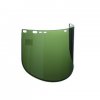The one thing I've learned about doing visors for both jango/mandolorian helmets and a phase 2 clone is that you've gotta be patient with it and not rush into it...and the one thing I wish I did from the get go - ALWAYS fit your visor before you paint!!
As for your particular situation, you used Acrylic. That would be fine if you had proper forming/heating equipment to give it the proper curves, however, if you're like me, only having a heat gun, you're gonna have a bad time. Like what
alienbuilder recommended, that is something you should use. It's not terribly thick and can be cut easily with a dremel. Additionally, it's already got a natural curve to it. Yes, you may need to tweak it, but it's a very good starting point. If you look around, you may be able to find even thinner material. The thinner it is (not paper thin) the easier it is to get it to sit "flush" against the inner edge, making it appear much nicer and "cleaner" in the long run
For the clone helmet I did do, you've got the right idea of tracing the visor area, but remember that while the visor shape itself is a part of the helmet, the visor material doesn't need to be that shape, so long as when viewed from the outside, there are no visible gaps. This allows you to have more material on the interior to attach it to.
Attaching the visor. There's really nothing special in my experience. The majority of my previous commissions have had the visor hot-glued in using HIGH temprature type hot glue. If you use the cheap stuff from a craft store, you're more than likely going to have issues later on. Believe it or not, not just the heat from the sun but even extreme colds can cause hot glue to be come brittle or detach itself from the surface. Not that you're planning to be in either but when it comes to transport and storage, it's something to consider. Fortunately, I have not had much trouble with hot glue, except for one instance (didn't use High temp!). When you go to install the visor, don't smother it with the hot glue. Tack it in place with small globs around the material so that it can hold itself in place. Check the fit, see what other issues there are and adjust accordingly. It's much easier to pull it off and start over with the small globs than it is to cover the whole thing on the first attempt. Once you got it how you like, it's now much easier for you to add more hot glue in a controlled manner, since it's tacked in place and you're not fumbling around trying to hold the visor down.
The other method, which is much more tedious, difficult but works well if done correctly, is adding threaded female posts to the interior of the helmet along key points around the visor and using bolts to secure the visor down. The biggest issues you'll have with this, is 1) ensuring what ever adhesive you use to hold down those posts is good enough to withstand the pressure of tightening a bolt. 2) Placement/alignment can be tricky, as easy as it may look, if your post's angle is off in one direction, you may find your visor itself won't allow you to line up the holes. 3) you may need to "sink" the female/post ends into the surface of the helmet interior. I say this because if you use something that has a wide base (preferably) and you simply stick it on the inside, you're going to have a small, but noticeable gap between the visor and helmet. Marking, and taking a dremel to carve a shallow pit for the post to sit inside will allow you to get the visor material as tight to the helmet as possible.
If done correctly, the bolt method will allow you to "pull" the trouble areas of the visor that don't want to sit flush if you used hot glue. I have done multiple Jango fett/mando helmet builds and the visor is always a pain. I built my Montross helmet, using bolts to hold the visor and it looks way better than any of my previous helmet's visors.
Again though, this is how I've done some things, but everyone has their own thoughts..


